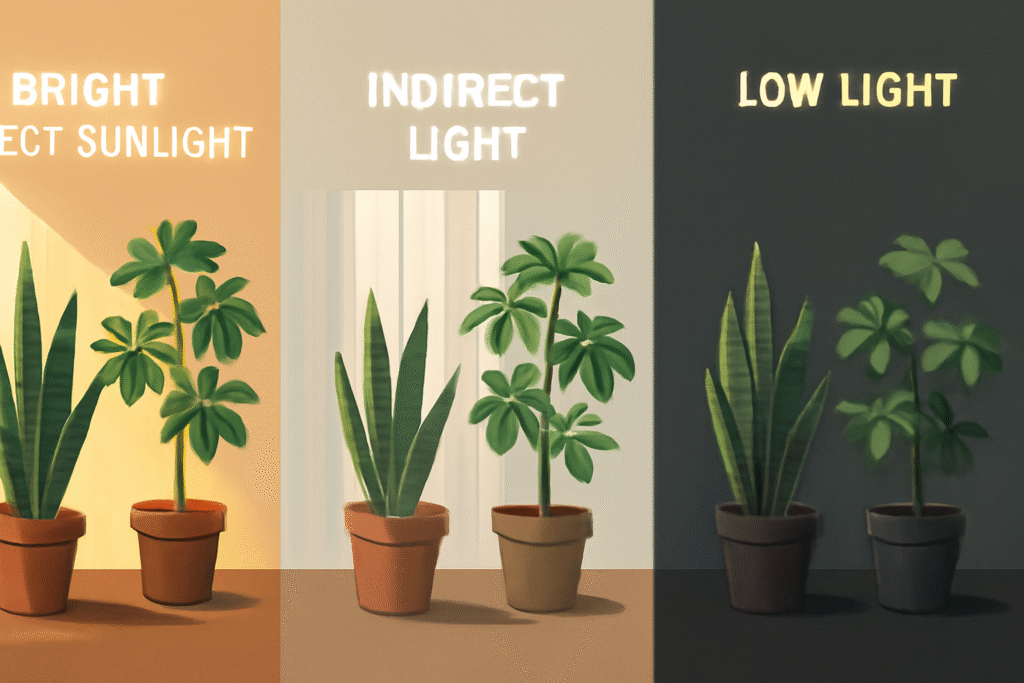
Light Requirements for Different Indoor Plants: A Complete Guide to Choosing the Right Lighting for Your Greenery
Have you ever wondered why your indoor plants are struggling to thrive, despite your best efforts? 
In this comprehensive guide, we’ll break down the light needs of various indoor plants and share practical tips to ensure your plants get the ideal lighting they require. Say goodbye to guessing games and plant stress—by the end of this article, you’ll have the knowledge to create the perfect lighting environment for all your green friends! Keep reading to uncover how simple changes in lighting can help your plants flourish.
Table of Contents
ToggleUnderstanding the Basics of Plant Lighting
When it comes to indoor plants, light is a vital factor that can make or break their health. But what exactly do plants need when it comes to light? 
What is Light Intensity and Why Does It Matter?
Light intensity refers to how much light reaches your plant, which can directly impact its ability to photosynthesize and grow. Plants can be categorized into three main light needs: high light, moderate light, and low light. Understanding the difference between these types is crucial to keeping your plants healthy.
- High light: Plants that need a lot of direct sunlight, like succulents and cacti, thrive in bright, sun-filled spaces.
- Moderate light: These plants, such as spider plants and pothos, do best in indirect light or light that’s filtered by a sheer curtain.
- Low light: Plants like snake plants and peace lilies can survive with very little sunlight, often thriving in dimmer rooms or corners.
Natural vs. Artificial Light
While natural light from the sun is ideal for most plants, it isn’t always reliable—especially in homes with limited window space or during cloudy months. That’s where artificial light comes in. Let’s look at both options:
- Natural Light: Sunlight is the best form of light for plants as it contains the full spectrum of light they need to grow. The intensity of natural light changes throughout the day, so it’s important to know where your plants are positioned relative to the sun.
- Artificial Light: For areas with low natural light, grow lights can be a game-changer. These lights mimic the full spectrum of sunlight and can be customized to suit different types of plants. Depending on your plant’s light needs, you can choose from LED grow lights, fluorescent lights, or incandescent lights.
Each type of light has its pros and cons. While natural light is free, it’s often inconsistent. Artificial lights, on the other hand, provide more control, but come with a cost.
Light Duration: How Long Should Your Plants Be Exposed to Light?
Plants don’t just need light—they need the right duration of light exposure. Most indoor plants require 6-12 hours of light daily to thrive. However, different plants have different needs:
- High-light plants (like succulents) may need closer to 12 hours of light.
- Moderate-light plants can do well with about 8 hours of light.
- Low-light plants may only require about 6 hours of indirect light or even less.
If your home doesn’t get enough natural light, artificial grow lights can help you provide the right amount of exposure to your plants.
Why Understanding Light Matters
Understanding the light requirements for different indoor plants is critical for their survival and health. Plants that receive too little light may grow slowly, become leggy, or have yellow leaves, while those exposed to too much direct light may get sunburned, resulting in crispy, brown leaves.
By knowing the right type of light, intensity, and duration for your plants, you’ll be able to create an environment where they can thrive, ensuring lush greenery in your home.
Identifying the Light Needs of Popular Indoor Plants
Every indoor plant has its own unique light requirements, and understanding these needs is key to helping your greenery thrive. In this section, we’ll break down the light preferences of some of the most popular indoor plants. Whether you’re a beginner or a seasoned plant enthusiast, knowing what your plants need is essential to ensuring they stay healthy and happy.
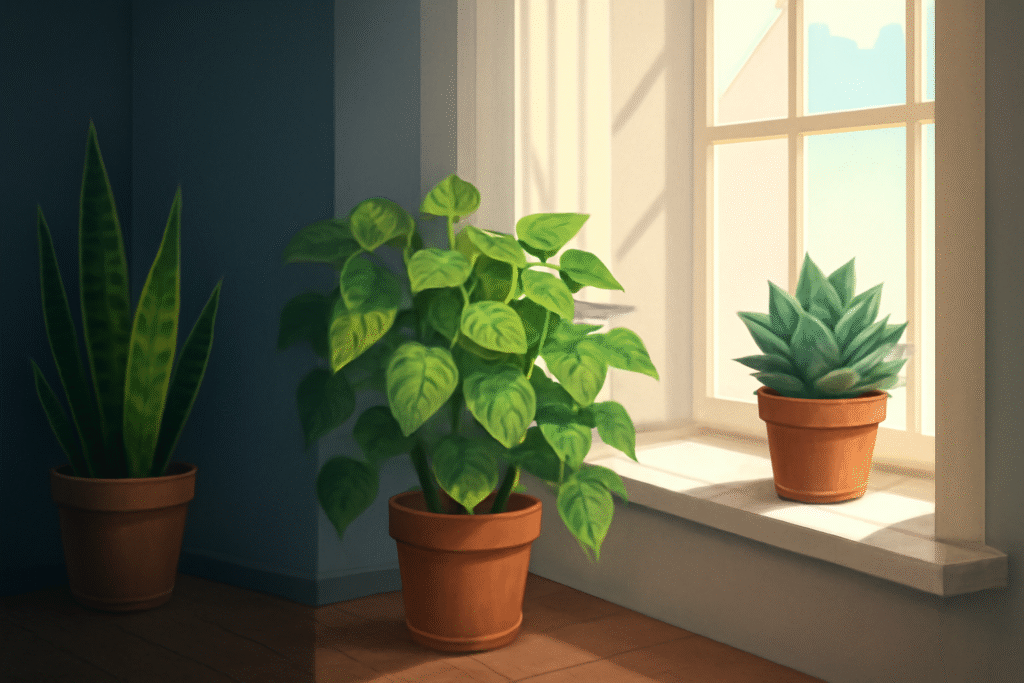
Low-Light Plants 
These plants can survive in spaces with limited natural light. They are perfect for areas of your home that don’t receive direct sunlight, like hallways, bathrooms, or offices.
- Examples:
- Snake Plant: Thrives in low-light conditions and can handle neglect. It’s perfect for those who aren’t always around to tend to their plants.
- Peace Lily: Prefers indirect light but can tolerate lower light levels. A great option for dimmer rooms.
- ZZ Plant: Known for its resilience, it can thrive in low light with little care.
- Lighting Tips:
- Keep these plants away from direct sunlight to avoid sunburn, which can cause their leaves to scorch.
- These plants can often survive with only a few hours of indirect light per day.
Moderate-Light Plants 
Moderate-light plants need more light than low-light plants, but they still do best with indirect or filtered sunlight. These are ideal for spaces near windows with sheer curtains or bright, indirect lighting.
- Examples:
- Spider Plant: Prefers bright, indirect light but can adapt to medium light conditions.
- Philodendron: Thrives in moderate light and can be placed in most rooms with indirect sunlight.
- Pothos: A hardy plant that grows well in moderate light, although it can adapt to low light with slower growth.
- Lighting Tips:
- Place them near windows that get indirect light for a few hours a day.
- If natural light is limited, a grow light positioned a few feet away can also work wonders.
High-Light Plants 
High-light plants love bright, direct sunlight and need lots of it to thrive. These plants do best near windows that face south or west, where sunlight is strongest.
- Examples:
- Succulents (like Echeveria): These sun-loving plants need direct light and do best when placed in sunny spots.
- Fiddle Leaf Fig: This popular plant needs bright, direct light to grow properly, especially when young.
- Cacti: Cacti love the sun and should be placed in a spot that gets several hours of direct sunlight each day.
- Lighting Tips:
- Place these plants in areas where they can receive several hours of direct sunlight each day, such as a south-facing window.
- If you’re using artificial lights, make sure to provide them with a high-intensity, full-spectrum grow light for 12-16 hours per day.
Determining Light Intensity and Duration for Each Plant
Understanding the specific light intensity (how bright the light is) and duration (how long your plant is exposed to light) for each plant type is essential. Here’s a quick reference guide:
- Low-light plants: These can thrive in spaces with 2-4 hours of indirect light.
- Moderate-light plants: These require 4-6 hours of indirect sunlight or moderate artificial lighting.
- High-light plants: These plants need 6-8 hours of direct sunlight or strong artificial light daily.
By identifying the correct light requirements for your indoor plants, you’ll be able to create a personalized care routine that ensures your greenery flourishes in the best environment possible!
How to Assess the Light Levels in Your Home
Understanding how much light your indoor plants are getting is essential for keeping them healthy and thriving. In this section, we’ll walk you through simple ways to assess the light levels in your home. Once you know how much light each room or space receives, you’ll be better equipped to place your plants in the ideal spots.
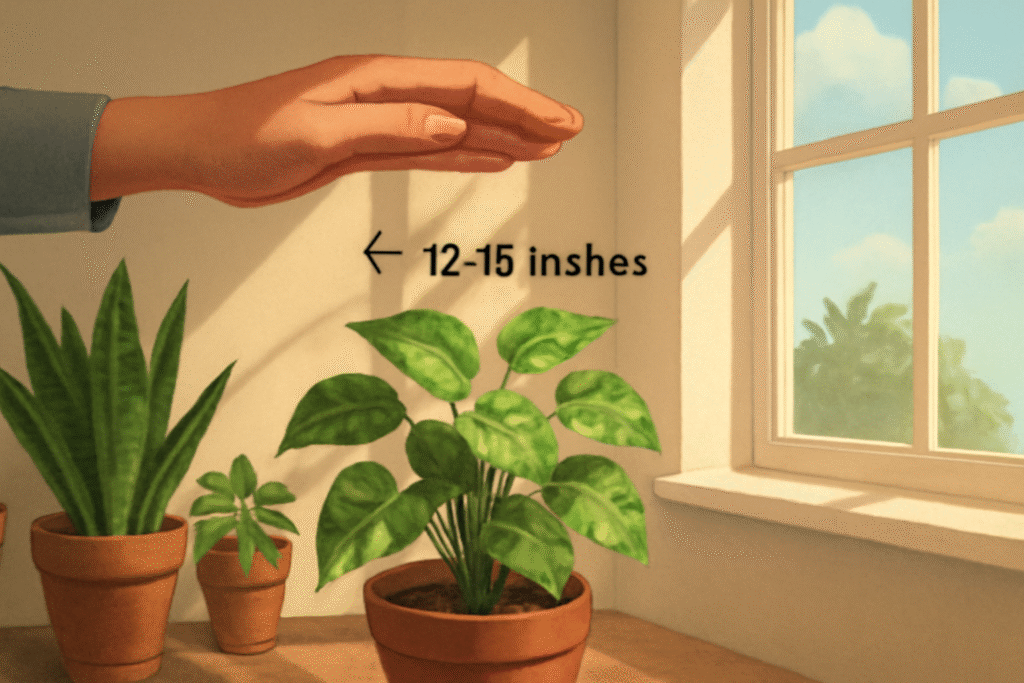
1. Observe the Natural Light in Each Room
The first step in assessing light levels is to observe how much natural light each room gets throughout the day. Pay attention to the direction your windows face and how the light changes over time. Here’s how:
- South-facing windows: These rooms get the most direct sunlight throughout the day, providing high light. Perfect for plants that need lots of sun, like succulents or cacti.
- East-facing windows: These rooms get morning sun, which is typically softer and less intense. This is great for moderate-light plants like spider plants or pothos.
- West-facing windows: These rooms receive strong afternoon sun, so they’re ideal for plants that need high light, but they may need some shading if the sun is too intense.
- North-facing windows: These rooms generally receive the least sunlight and are best for low-light plants, as they offer indirect light for much of the day.
Quick Tip: Spend a day tracking the sunlight in different areas of your home. You’ll get a better idea of which spots are the brightest and which are more dimly lit.
2. Use the “Hand Test” to Measure Light Intensity
If you’re unsure about how much light a particular spot is getting, you can use the “hand test”. Hold your hand about 12-18 inches above the area where you want to place your plant. Here’s what to look for:
- Bright Light: If the shadow of your hand is sharp and clear, it’s likely receiving direct sunlight. This is great for high-light plants.
- Moderate Light: If the shadow is softer and less distinct, it indicates indirect light. This is perfect for moderate-light plants.
- Low Light: If there’s no clear shadow and the area feels dark, it’s a low-light space, suitable for plants that don’t need much sun.
3. Use a Light Meter or Light Intensity App
For a more precise reading, you can invest in a light meter or download a light intensity app on your smartphone. These tools measure the exact amount of light in terms of lux (light intensity), helping you determine whether your plants are getting enough light.
- Low light: 50-200 lux (ideal for low-light plants)
- Moderate light: 200-1000 lux (perfect for moderate-light plants)
- High light: 1000+ lux (needed for high-light plants)
These devices can be helpful if you want to create a more precise lighting setup in your home.
4. Track Light Changes Throughout the Day
Natural light shifts throughout the day, so it’s important to track how much light each spot receives at different times. For example, a spot near a window may get bright morning sunlight but be in shade by the afternoon. To find the best spots for your plants:
- Morning Light: Gentle and ideal for plants that need moderate light.
- Midday Light: Strong and intense—best for high-light plants.
- Afternoon Light: Similar to midday light but can be more intense depending on the direction of the sun. Use caution with delicate plants.
By observing the light levels at different times, you’ll be able to place your plants in the best spots based on their specific needs.
5. Consider Using Artificial Light for Supplemental Illumination
If your home has areas with limited natural light, or if you simply want to enhance the light for your plants, consider using artificial grow lights. These can supplement natural sunlight, especially in darker areas.
- Full-spectrum LED lights mimic natural sunlight and are energy-efficient.
- Fluorescent lights provide a good balance of light for moderate-light plants.
- Incandescent lights are less ideal for plants, as they tend to emit heat and aren’t as effective for photosynthesis.
Artificial lights are particularly helpful in spaces that don’t get enough natural light, ensuring your plants get the exposure they need to grow strong and healthy.
Adjusting Light Conditions for Your Indoor Plants
Even if you’ve assessed the light levels in your home, sometimes your plants still need a little help to get the right amount of light. In this section, we’ll show you how to adjust light conditions to create the perfect environment for your indoor greenery. Whether you’re dealing with too little light or too much, these tips will ensure your plants get exactly what they need to thrive.
1. When There’s Not Enough Natural Light
If your plants aren’t getting enough natural sunlight, don’t worry—you can make adjustments to help them out. Here’s how:
- Move Your Plants Closer to Windows: Sometimes, simply shifting your plant closer to a window can provide more light. Try placing your plants on windowsills or shelves that are closer to sunlight. For low-light plants, this can be enough to meet their needs.
- Use Sheer Curtains to Filter Light: If your plants are in a spot with too much direct sunlight, sheer curtains can help diffuse the light and provide a gentle glow. This is especially helpful for moderate-light plants, like pothos and spider plants, which need indirect light.
- Add Supplemental Artificial Light: If natural light is limited, consider using artificial grow lights. Full-spectrum LED lights are ideal for plants that need moderate to high light. They mimic the sun’s rays, ensuring your plants get the right spectrum for healthy growth.
Quick Tip: Place your grow lights about 6-12 inches above your plants for the best results. Keep the lights on for 10-14 hours a day to simulate natural daylight.
2. When There’s Too Much Light
Excessive direct sunlight can be just as harmful as too little light, leading to sunburn and leaf damage. If your plants are getting too much sun, here’s what you can do:
- Move Plants to a Shaded Area: If you notice your plants getting scorched or the leaves turning brown, try moving them away from direct sunlight. A spot that gets bright, indirect light can still provide the light your plants need without the risk of sunburn.
- Use Window Films or Shades: If a room gets intense afternoon sunlight, consider installing window films or shades to reduce the light intensity. This will protect your plants from the harsh rays while still allowing for bright, indirect light to filter through.
- Rotate Your Plants: Moving your plants around periodically ensures that all sides get equal exposure to light, preventing one side from becoming too scorched while the other side remains too shaded.
3. Creating a Light Schedule with Artificial Lights
If you rely on artificial grow lights, it’s important to create a light schedule to mimic natural sunlight cycles. This will help your plants grow stronger and healthier:
- Set a Timer: Use a timer to turn the grow lights on and off automatically. This will help you maintain a consistent light schedule for your plants, so they get the right amount of exposure each day.
- Adjust the Duration Based on Plant Type: As mentioned earlier, high-light plants need about 12-16 hours of light per day, while low-light plants can thrive with just 6-8 hours of light. Adjust the timer accordingly to meet the needs of each plant.
4. Grouping Plants Based on Light Requirements
One of the easiest ways to optimize your indoor garden’s light conditions is by grouping plants with similar light needs together. This way, each plant gets the ideal amount of light without any of them being overexposed or neglected. Here’s how:
- High-Light Plants: Group succulents, cacti, and fiddle leaf figs together in a spot that gets bright, direct light.
- Moderate-Light Plants: Place plants like spider plants, pothos, and peace lilies in a bright, indirect light area or under a grow light.
- Low-Light Plants: Keep snake plants, zz plants, and philodendrons in corners or areas with low light.
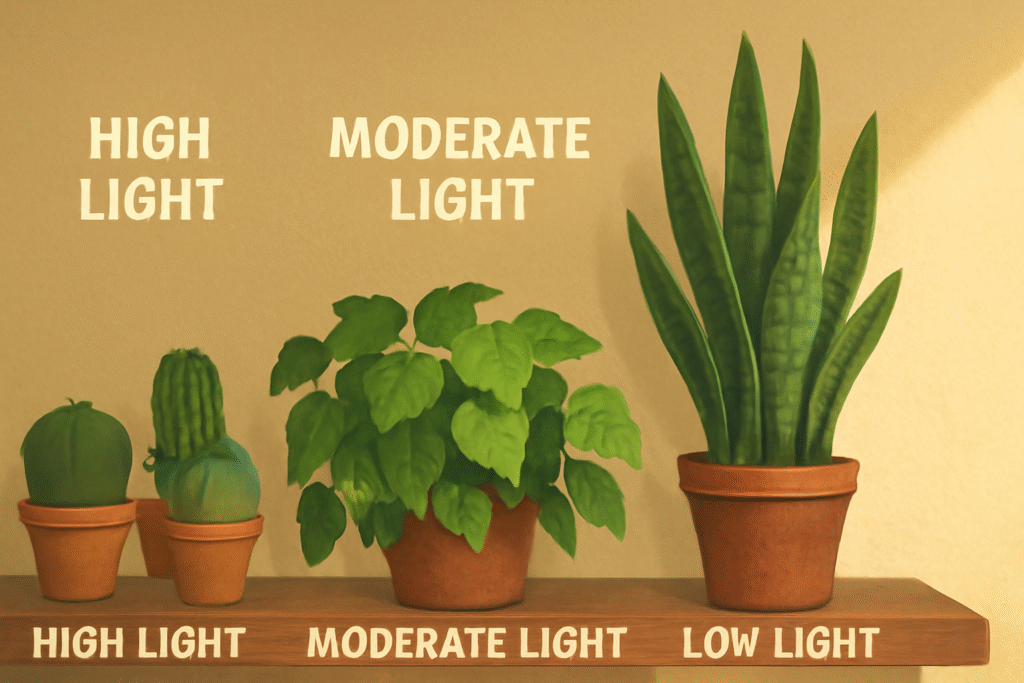
This strategy helps you create a balanced environment and ensures that each plant gets the right light for its needs.
How to Choose the Right Grow Light for Your Plants
If natural sunlight isn’t enough to meet your plants’ needs, grow lights can provide the extra boost your greenery requires to thrive indoors. But with so many options on the market, how do you choose the best one for your plants? In this section, we’ll help you understand the different types of grow lights and how to select the right one based on your plant’s needs.
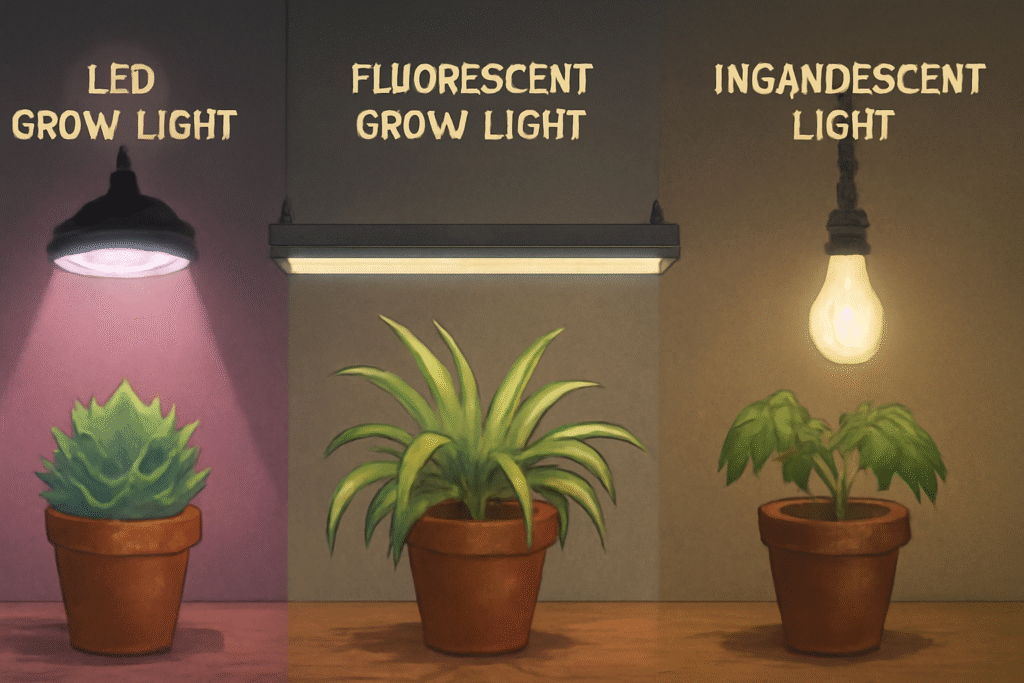
1. Types of Grow Lights
There are several types of grow lights available, each with its own unique features. Here’s a breakdown of the most common options:
- LED Grow Lights
:
- Best for: All types of plants (low, moderate, and high light).
- Why choose LED: Energy-efficient, long-lasting, and emit low heat. LED lights are also customizable with full-spectrum options, making them ideal for providing the right light for different plant types.
- Tip: Choose full-spectrum LED lights for a broad light spectrum that mimics natural sunlight. This is essential for healthy plant growth.
- Fluorescent Grow Lights
:
- Best for: Low to moderate light plants.
- Why choose fluorescent: Less expensive than LED lights, and they produce a cool light that’s perfect for plants like ferns, pothos, and spider plants. They are also energy-efficient, though they aren’t as long-lasting as LEDs.
- Tip: Compact fluorescent lights (CFLs) or T5 tubes work well for indoor plants and can be placed closer to plants without causing heat damage.
- Incandescent Grow Lights
:
- Best for: Not recommended for most indoor plants.
- Why avoid: While incandescent bulbs are affordable, they produce too much heat and offer a narrow spectrum of light, making them inefficient for plant growth.
- Tip: If you have one, use it only for short periods and avoid placing it too close to your plants.
2. Choosing the Right Spectrum for Your Plants 
Plants require different light spectrums depending on their growth stage. Here’s a quick guide to understanding which spectrum suits your plants:
- Blue Light (400-500 nm):
- Encourages leaf growth and strong, compact plants.
- Ideal for vegetative growth stages (e.g., leafy greens and herbs).
- Best for: Low and moderate-light plants like peace lilies and pothos.
- Red Light (600-700 nm):
- Promotes flowering and fruiting in plants.
- Essential for flowering plants or those in the bloom stage.
- Best for: High-light plants like succulents, cacti, and flowering houseplants.
- Full-Spectrum Light:
- Mimics natural sunlight, providing a balance of red, blue, and other colors.
- Best for: All types of plants, especially if you want to promote both healthy leaves and blooms.
3. How to Determine the Right Wattage and Coverage Area
When choosing a grow light, you need to consider how much power your plant requires, based on the space it occupies. Here’s how to determine the right wattage and coverage:
- Low-light plants: Typically need 10-20 watts per square foot of light intensity.
- Moderate-light plants: Need 20-30 watts per square foot.
- High-light plants: Require 30-50 watts or more per square foot, especially for large plants or those that need a lot of sunlight.
It’s also important to know the coverage area of your grow light. Check the packaging or product specifications to ensure that the light can cover the area where you plan to place your plants.
4. Placement and Duration of Grow Lights
The placement and duration of your grow light can significantly impact its effectiveness:
- Distance from Plants:
- Place grow lights about 6-12 inches above your plants. If the light is too close, it can burn the leaves; if it’s too far, the light intensity may not be strong enough.
- Duration:
- Most indoor plants require 10-16 hours of light per day, depending on their needs.
- Use a timer to automate the light cycle and ensure consistency for your plants.
Quick Tip: Rotate your plants every few weeks to ensure that all sides receive equal exposure to the grow light.
5. Additional Tips for Grow Light Success
- Use Reflectors: Placing reflective materials like white walls or aluminum foil around your grow light setup can help distribute light more evenly across your plants.
- Monitor Plant Health: Watch your plants closely for signs of stress, such as leaf yellowing or stretching. If you notice these signs, adjust the light intensity or duration accordingly.
Troubleshooting Common Light-Related Problems
Even with the best care, your plants may still face light-related challenges. Don’t worry—many of these issues are easy to fix once you know what to look for! In this section, we’ll walk you through common light problems and practical solutions to get your plants back on track.
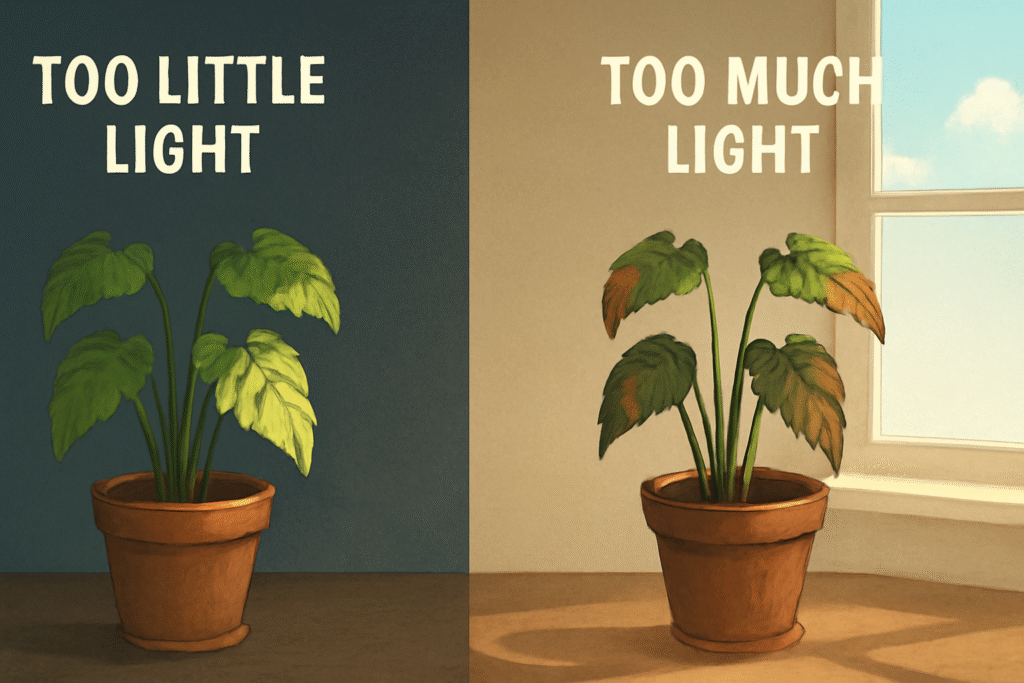
1. Yellowing Leaves (Too Little Light)
Problem: If your plant’s leaves start turning yellow, it could be a sign that it’s not getting enough light. Plants need adequate light to produce chlorophyll, and without it, the leaves may lose their vibrant color.
Solution:
- Move your plant closer to a light source—preferably a window with indirect sunlight.
- If natural light is insufficient, consider using grow lights to supplement the light your plant needs.
- Rotate your plants regularly to ensure all sides are exposed to the light.
2. Leggy or Stretched Growth (Too Little Light)
Problem: When plants don’t receive enough light, they tend to become “leggy,” meaning their stems stretch out and grow long with fewer leaves. This happens because the plant is trying to reach for more light.
Solution:
- Increase the light intensity by moving your plant closer to a window or installing a grow light.
- Prune the plant to encourage healthier, bushier growth. Cutting back the leggy stems will also help redistribute energy to the plant’s core.
3. Brown Leaf Tips or Sunburn (Too Much Light)
Problem: If your plant’s leaves have crispy, brown edges or spots, it could be getting too much direct sunlight. Many plants, especially those that prefer indirect light, can get sunburned if exposed to harsh rays for too long.
Solution:
- Move the plant to a spot with indirect or filtered light—you can use sheer curtains or window films to soften the sunlight.
- For plants that prefer low or moderate light, avoid placing them directly in the sun. Use grow lights as a more controlled option if needed.
4. Pale or Yellowing Leaves with Slow Growth (Too Much or Too Little Light)
Problem: If your plant’s leaves are pale and its growth seems slow, it could be an indication that the plant isn’t getting the right amount of light. It’s possible the plant is getting either too much direct light or too little light, both of which can stunt growth.
Solution:
- Check the light intensity and adjust accordingly. Move your plant closer to a window for more light (but away from direct sun if necessary).
- Consider adding a grow light if natural light is insufficient. Make sure to match the light duration and intensity with your plant’s needs.
5. Leaves Curling or Drooping (Inconsistent Light)
Problem: If the leaves of your plant start curling or drooping, it may be due to inconsistent light exposure. Some plants can get stressed if their light conditions change too frequently.
Solution:
- Ensure your plant is in a stable light spot with consistent exposure. If you’re using grow lights, make sure they are on a regular timer.
- Avoid placing plants in areas where light fluctuates throughout the day, such as near an air conditioner or in spots where the sun moves rapidly.
6. Lack of Flowering or Poor Growth (Not Enough Light)
Problem: If your plant is not flowering or showing poor growth, it might not be receiving enough light. Plants that require high light to bloom or grow strong roots need to have consistent access to bright light.
Solution:
- Move your plant to a sunnier location or invest in a stronger grow light if the natural light in your home is lacking.
- Keep in mind that full-spectrum lights are best for encouraging growth and flowering in plants that need more intense light, such as succulents or flowering houseplants.
Congratulations—you’re now equipped with everything you need to understand and optimize the light requirements for different indoor plants! 
Remember, the key to healthy indoor plants is understanding their specific light needs. Whether you have high-light succulents, moderate-light pothos, or low-light snake plants, giving them the right amount of light will make all the difference in their growth and overall health.
Here are a few final tips to keep in mind:
- Observe your plants regularly and adjust their light exposure if needed.
- Experiment with light setups to see what works best for your plants.
- Don’t be afraid to use artificial grow lights to supplement natural sunlight, especially in darker areas of your home.
By following these guidelines, you’ll be well on your way to building a lush, thriving indoor garden.
Have questions or want to share your plant care experiences? Drop a comment below—we’d love to hear from you! And don’t forget to subscribe for more expert tips on indoor plant care.
Happy planting!
Frequently Asked Questions (FAQs)
1. How do I know if my plant is getting enough light?
To check if your plant is getting enough light, observe its growth and leaves. If the leaves turn yellow or the plant becomes leggy with stretched stems, it may need more light. For plants that are too close to direct sunlight, look for brown, crispy edges on the leaves. Adjust its position or use a grow light to improve its exposure. 🌞🌿
2. What type of light do indoor plants need?
Indoor plants generally need bright, indirect light to thrive. High-light plants (like succulents) need direct sunlight, while low-light plants (like snake plants) can survive with minimal light. Understanding your plant’s specific needs helps ensure healthy growth. 💡🌱
3. Can plants survive with just artificial light?
Yes, many indoor plants can thrive with artificial light, especially in areas with limited natural light. Full-spectrum LED lights or fluorescent lights can provide the right light spectrum for plants. Choose the light type based on your plant’s light requirements and position the lights properly. 💡🌿
4. How long should indoor plants be exposed to light each day?
Most indoor plants need 6 to 12 hours of light per day, depending on their type. High-light plants may require up to 12 hours, while low-light plants only need around 6 hours. Using a timer with grow lights can help maintain consistent exposure. 🕒🌞
5. What is the difference between direct and indirect light for plants?
Direct light refers to sunlight that hits the plant directly, such as when it’s near a window that faces the sun. Indirect light is sunlight that is diffused or filtered, like through a sheer curtain or reflecting off walls. Most indoor plants do best with indirect light to avoid burning their leaves. 🌞➡️🌿
6. Can I use regular household lights for my plants?
Regular household lights typically don’t provide the full spectrum of light plants need. For optimal growth, it’s best to use grow lights that offer a broader spectrum of light, especially if your home has limited natural sunlight. Regular lights might help temporarily but are not ideal for long-term plant health. 💡🌱
7. Why are my plant’s leaves turning yellow and falling off?
Yellowing leaves can indicate that your plant is not getting enough light or is being exposed to too much direct light. Ensure your plant is in the right spot based on its light needs and adjust its position accordingly. Low-light plants need less exposure, while high-light plants need more direct sunlight. 🌿💡
8. How do I know if my plant is getting too much light?
If your plant is exposed to too much light, you may notice brown, crispy edges on its leaves or patches that look scorched. High-light plants can tolerate direct sun, but others (like ferns or peace lilies) may need protection from harsh rays. Move the plant to a spot with indirect light or use curtains to diffuse the sunlight. 🌞🚫








